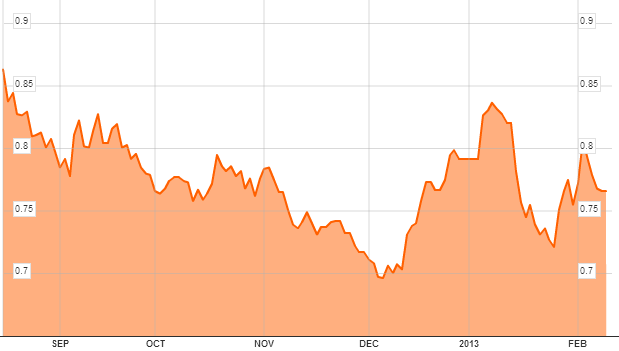Japanese stocks are off to a nice start this year. The iShares MSCI Japan ETF (NYSE:$EWJ), a popular option among investors for getting access to Japan’s biggest traded companies, is up 4% for the year and 14% over the past month.
Enjoy it while it lasts.
Japan’s recent surge is due to its new quantitative easing program—its largest in years—and the stated intentions of Prime Minister Shinzo Abe to weaken the value of the yen and boot Japan out of the deflationary slump it’s been in for the better part of two decades.
But Abe should be very careful what he wishes for. Deflation is what keeps Japan’s borrowing costs as low as they are. At time of writing, Japan’s 10-year government bonds yield a pitiful 0.75%. According to financial writer John Mauldin, an increase of just 100 basis points in borrowing costs would devour 10% of tax revenues.

Writing for Bloomberg, Gary Shilling notes that debt service now accounts for 43% of Japanese government revenues and quarter of all spending. Furthermore, more than half of all Japanese government spending is financed by new borrowing. This means that half of every yen borrowed is used to service existing debts. It’s a debtor’s nightmare that gets worse every year with budget deficits that are consistently higher than 7% of GDP.
All of this has been made possible by Japan’s seemingly inexhaustible supply of domestic borrowers. But those days are now over. As Japan’s population ages, its savings rate plummets. Once you stop working, you stop saving and you start living off your investments instead. As Japan is the oldest country in the world (and rapidly getting older) its savings rate has shrunk below that of the free-spending United States.
This means that Japan has two choices going forward. Tap the international bond market and risk the beating that Spain and Italy took last year or finance the government directly via the central bank. Neither of these two scenarios end well.
How long can this song and dance last? It’s impossible to say, but you’ll know ahead of time that it is coming to an end. Eventually the bond market vigilantes will wake out of their stupor, and then the jig will be up.
Keep an eye on the Japanese 10-year yield. Thus far, it hasn’t budged much in response to the quantitative easing plans. Yields popped from 70 basis points to 84 basis points before drifting back to current levels.
When the yield approaches 1.5%, get ready for the short opportunity of a lifetime in Japanese assets. Because once Japan loses control of the situation, it will be only a short matter of time before it implodes into a hyperinflationary meltdown.
This article first appeared on MarketWatch.
SUBSCRIBE to Sizemore Insights via e-mail today.

[…] post Japan is Running Out of Time appeared first on Sizemore […]
[…] post Japan is Running Out of Time appeared first on Sizemore […]
[…] and this is benefitting Toyota (NYSE:$TM) and Honda (NYSE:$HMC). I see this ending badly—see “Japan is Running Out of Time”—and I would not recommend having any long-term positions in Japanese stocks. But for the […]
[…] As I wrote in February, “debt service now accounts for 43% of Japanese government revenues and quarter of all spending. Furthermore, more than half of all Japanese government spending is financed by new borrowing… It’s a debtor’s nightmare.” […]
[…] I wrote in February, “debt service now accounts for 43% of Japanese government revenues and quarter of all […]